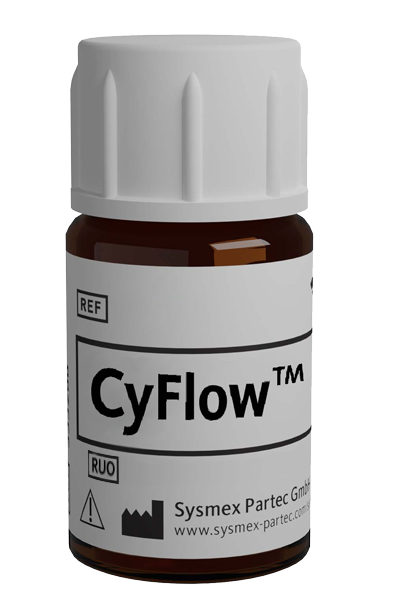CyFlow™ CD90.2 PE

| Antibody: | Yes |
| Antigen: | CD90.2 |
| Application: | Flow cytometry |
| Clonality: | monoclonal |
| Clone: | 1aG4/C5 |
| Emission Maximum: | 576 nm |
| Excitation Maximum: | 496 nm, 565 nm |
| Field of Interest: | Immunophenotyping, MHC |
| Format/Fluorochrome: | PE |
| Isotype: | IgG3 |
| Laser: | Blue , Green, Yellow |
| Regulatory Status: | RUO |
| Source Species: | Mouse |
| Target Species: | Mouse |
| Product number: | CN347786 |
For Research Use Only
| Concentration Unit | mg/mL |
| Concentration | 0,1 |
| Quantity | 0.1 mg |
| Volume | 1.0 mL |
| Immunogen | Thymocytes from C3H/Di mice (Thy-1.2 positive) |
| Background Information | CD90 (Thy-1) is an 18-35 kDa GPI-anchored plasma membrane glycoprotein expressed in many cell types, such as in hematopoietic cells and neurons, connective tissues, various fibroblast and stromal cell lines, tumor endothelial cell lines and other. In the mouse, CD90 is expressed mainly on thymocytes and peripheral T lymphocytes. It is involved in T cell activation, cellular adhesion, proliferation and migration, neurite outgrowth, wound healing, apoptosis, and fibrosis. CD90 participates in multiple signaling cascades and its effects are tissue- and cell type-specific. It often functions as an important regulator of cell-cell and cell-matrix interactions. |
| Usage | The reagent is designed for Flow Cytometry analysis. Working concentrations should be determined by the investigator. |
| Storage Buffer | The reagent is provided in stabilizing phosphate buffered saline (PBS) solution, pH ≈7.4, containing 0.09% (w/v) sodium azide. |
| Storage | Avoid prolonged exposure to light. Store in the dark at 2-8°C. Do not freeze. |
| Stability | Do not use after expiration date stamped on vial label. |
| Draber P, Zikan J, Vogtiskova M: Establishment and characterization of permanent murine hybridomas secreting monoclonal anti‑thy‑1 antibodies. J Immunogenet. 1980 Dec; 7(6):455‑74. < PMID: 6787139 > | Zikan J, Draber P, Vojtiskova M: Monoclonal IgG3 (kappa) antibodies against murine Thy‑1.2 antigen produced by murine hybridomas: Differences in the specificity of the antigen binding site and in the structure of the hinge region. Folia Biol (Praha). 1982; 28(6):377‑94. < PMID: 6186535 > | Draberova L, Draber P: Thy‑1 glycoprotein and src‑like protein‑tyrosine kinase p53/p56lyn are associated in large detergent‑resistant complexes in rat basophilic leukemiacells. Proc Natl Acad Sci USA. 1993 Apr 15; 90(8):3611‑5. < PMID: 7682713 > | Haeryfar SM, Hoskin DW: Thy‑1: more than a mouse pan‑T cell marker. J Immunol. 2004 Sep 15; 173(6):3581‑8. < PMID: 15356100 > | Rege TA, Hagood JS: Thy‑1 as a regulator of cell‑cell and cell‑matrix interactions in axon regeneration, apoptosis, adhesion, migration, cancer, and fibrosis. FASEB J. 2006 Jun; 20(8):1045‑54. < PMID: 16770003 > | Heneberg P, Lebduska P, Draberova L, Korb J, Draber P: Topography of plasma membrane microdomains and its consequences for mast cell signaling. Eur J Immunol. 2006 Oct; 36(10):2795‑806. < PMID: 17013982 > | Rege TA, Hagood JS: Thy‑1, a versatile modulator of signaling affecting cellular adhesion, proliferation, survival, and cytokine/growth factor responses. Biochim Biophys Acta. 2006 Oct; 1763(10):991‑9. < PMID: 16996153 > | Bradley JE, Ramirez G, Hagood JS: Roles and regulation of Thy‑1, a context‑dependent modulator of cell phenotype. Biofactors. 2009 May-Jun; 35(3):258‑65. < PMID: 19422052 >
